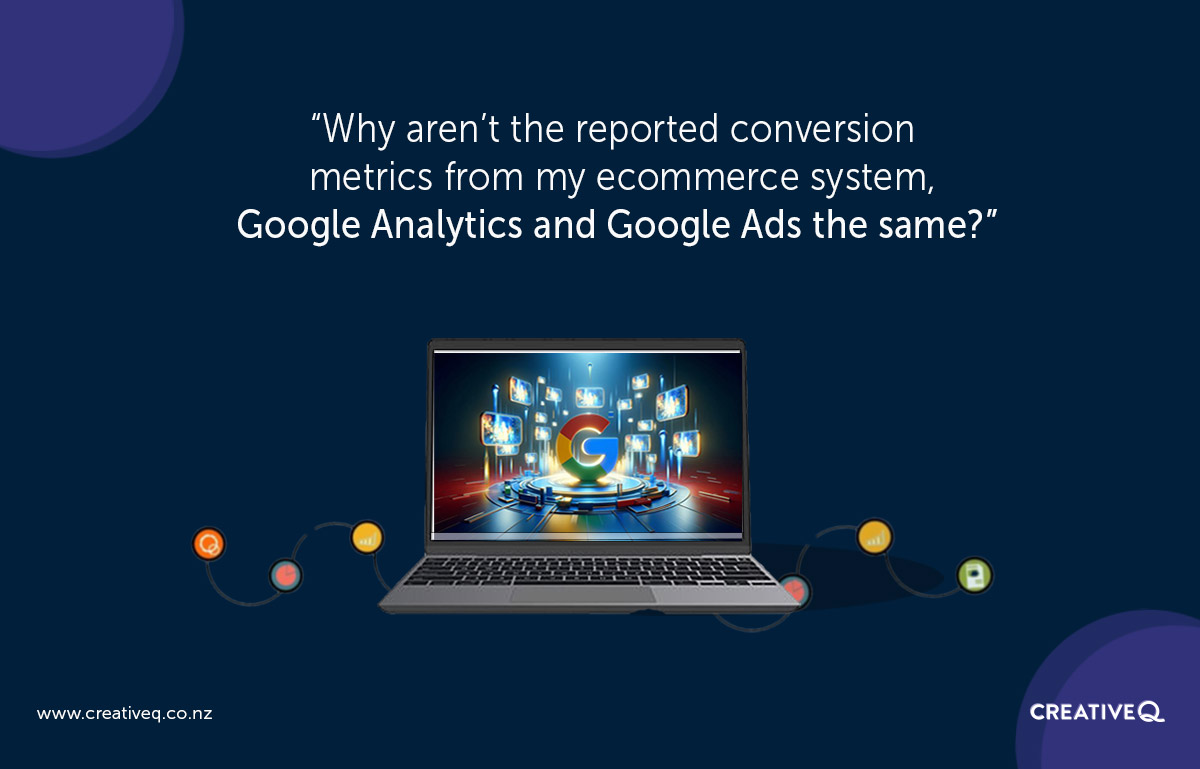This is a question we get asked a lot.
Sometimes the conversion numbers differ between the 3 sources (your ecommerce software, Google Analytics and Google Ads) by just a few percent, and sometimes the difference is 10% or more.
We commonly use Google Looker Studio for reporting on Google Ads activity, but any reporting software will have the same issues because they all use the same data sources.
Let’s take a closer look at each of the 3 sources of data for the numbers on these reports:
- Ecommerce software on your website (eg Shopify or Woocommerce)
- The most accurate source of ecommerce data (but even these systems a susceptible to occasional duplicate transactions or partial transactions)
- The data is for all your sales, not just the sales from your Google Ads activity. Your ecommerce software doesn’t know if the sale originated from your Google Ads, or a post on Facebook, or an organic Google Search result, or from an email you sent
- We can’t access your ecommerce data directly from your website, it needs to go through Google Analytics first
- Google Ads
- The most accurate source of your Google Ads data such as spend, clicks, impressions, click-through-rate, and non-ecommerce conversions such as form fills, phone number clicks, email address clicks etc. The software is watching the behaviour of website visitors that got to your site from an ad, and ignores website visitors that did not get to your site from an ad
- To collect data on ecommerce conversions, it relies on data that it pulls in from Google Analytics. It applies a filter to remove traffic that did not originate from an ad (this filter can start to distort the numbers)
- Timing is also an issue, because several seconds, minutes, hours, days or weeks, may lapse between a website visitor clicking on your ad, and completing a purchase
- Because Google Ads is combining it’s own non-ecommerce data and ecommerce data together, and applying a filter to try and remove website visitors that did not get to the site from an ad, the numbers can start to diverge
- Google Analytics
- Pulls in ecommerce data from your ecommerce software (eg Shopify or Woocommerce).
- Reliably is high, but not perfect. With any script on a website, sometimes it doesn’t load fully, so a small percentage of the data doesn’t make it to Google Analytics
- Collects data on all your website visitors and it is able to determine the source of those visitors (with a high degree of reliability), be it Google Ads, a post on Facebook, an organic Google Search result, or an email etc
So you can start to see why the data from these 3 software is seldom identical.
Here are a few examples how the 3 software could report different numbers:
- A prospect that has never visited your website before, sees your ad for the first time and visits your site but doesn’t make a purchase. 20 days later they remember your brand name, search Google from a different device, and click on an organic (non-ad) link to visit your site. This time they do complete a purchase.
- Because this person used a different device, it makes it difficult for Google to assign the sale to Google Ads (this is called cross-browser or cross-device tracking)
- A prospect is running script-blocking software on their device (which can block most ads and hides their personally identifiable information) but still sees an ad, and makes a purchase on the same day
- Your ecommerce software registers the sale, but perhaps the Google Analytics script is blocked and completely blind to the transaction, but Google Ads script does run and does track the conversion successfully
- A prospect sees an ad, clicks through to your website, the top half of your website loads quickly, but before the Google Analytics script loads, the prospect clicks the back button to go back to the previous page
- Google Ads reports that someone clicked on your ad and visited your website, but Google Analytics didn’t load fast enough so didn’t see the website visit at all
- A spam bot clicks on an ad and visits the site for a few seconds
- Google Ads detects the spambot and deletes this activity from your account (refunding the value of the click), but Google Analytics registers the visit as a visit from an ad
Having different numbers across your ecommerce software, Google Analytics reports and Google Ads reports is frustrating for everybody.
We employ a 2 pronged approach:
- We conduct periodic audits of tracking implementation and make improvements/adjustments when necessary
- Instead of fixating on specific numbers from individual platforms, we use these metrics collectively to gain insights and make informed decisions about the marketing strategy
We hope this helps.
If you have further questions, please don’t hesitate to reach out to us.
